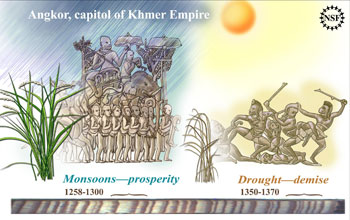Multimedia Gallery
Tree Rings Reveal Empire's End
In wet times, Angkor, the Khmer capitol thrived. Dry times coincided with its demise.
Studying tree rings has revealed a record of wet and dry times that helps make sense of the mysterious and gradual demise of Angkor, the capitol of the Khmer Empire in Cambodia from the 9th to 14th centuries. A very wet period with rich monsoons and plentiful crops from 1258 to 1300 was followed by many years of drought from 1350 to 1370.
This image accompanied NSF press release
"Climate Helped Bring Angkor to Its Knees."
Credit: Zina Deretsky, National Science Foundation
Images and other media in the National Science Foundation Multimedia Gallery are available for use in print and electronic material by NSF employees, members of the media, university staff, teachers and the general public. All media in the gallery are intended for personal, educational and nonprofit/non-commercial use only.
Images credited to the National Science Foundation, a federal agency, are in the public domain. The images were created by employees of the United States Government as part of their official duties or prepared by contractors as "works for hire" for NSF. You may freely use NSF-credited images and, at your discretion, credit NSF with a "Courtesy: National Science Foundation" notation.
Additional information about general usage can be found in Conditions.
Also Available:
Download the high-resolution JPG version of the image. (377 KB)
Use your mouse to right-click (Mac users may need to Ctrl-click) the link above and choose the option that will save the file or target to your computer.

